Teeming with Life The Wongaloo Project
Pamela Griffith



14 July - 20 August
Perc Tucker Regional Gallery
Pamela GriffithPublisher Gallery Services
Gallery Services, Townsville City Council
PO Box 1268
Townsville Queensland, 4810 Australia
ptrg@townsville.qld.gov.au
©Gallery Services, Townsville City Council and the authors 2017
ISBN: 978-0-949461-22-3
Organised by Gallery Services
Judith Jensen Acting Team Manager Galleries and Libraries
Erwin Cruz Exhibitions and Collection Coordinator
Louise Cummins Education and Programs Coordinator
Rob Donaldson Digital Media and Exhibition Design Coordinator
Jo Stacey Team Leader Administration Gallery Services
Carly Sheil Digital Media and Exhibition Design Officer
Samuel Smith Digital Media and Exhibition Design Fellow
Leonardo Valero Exhibitions Officer
Jacquelina Jakovljevic Exhibitions Officer
Sarah Monts Public Art Officer
Sarah Reddington Education and Programs Officer
Nicole Richardson Education and Programs Assistant
Danielle Berry Arts Officer
Wendy Bainbridge Gallery Assistant
Jo Lankester Gallery Assistant
Madisyn Zabel Gallery Assistant
Chloe Lindo Gallery Assistant
Cover image
Jabiru Nest [detail] 2015
Watercolour
25.5 x 32.5 cm (paper 35.5 x 43.0 cm)
Perc Tucker Regional Gallery
Cnr. Denham and Flinders St
Townsville QLD 4810
Mon - Fri: 10am - 5pm
Sat - Sun: 10am - 2pm
Published on the occasion of
14 July - 20 August
Perc Tucker Regional Gallery
Contributing Authors
Pamela Griffith
Judith Jensen
Joanna Mendelssohn
Penny Olsen
Publication Design and Development
Rob Donaldson
(07) 4727 9011
ptrg@townsville.qld.gov.au
whatson.townsville.qld.gov.au
PercTuckerTCC

Pamela Griffith, was born into an artistic family. She trained as an art teacher and later completed a Bachelor of Art (Ed). She taught in secondary schools and technical colleges, universities and privately. She is a talented draughtswoman and artist which is reflected in the artwork in this exhibition. Pamela uses a range of mediums; oils, acrylics, gouache, water-colour and pastels to depict her subject matter.
Her exhibition, Teeming with Life the Wongaloo Project celebrates the flora and fauna of the Wongaloo Wetlands, one of the largest intact coastal wetlands on Australia’s east coast. Located just south of Townsville, the wetland habitat with its bulkuru sedgeland is a significant breeding site for birds such as brolgas and magpie geese. It is also the habitat of other bird species such as herons, jabirus, spoonbills and jacana to name but a few. Her work conveys the beauty of the wetlands and its flora and fauna and raises our awareness of its delicate nature and vulnerability.
The artworks in this exhibition stem from the lived experiences of the artist who returned to the Wongaloo Wetlands three times to observe how the birdlife, mammals, reptiles and invertebrates interacted with their environment at different times of the year.
Four paintings in this exhibition tell the story of James Morrill, who, along with fellow-shipmates was shipwrecked off the coast of Queensland in 1846. After 22 days the surviving members of the party came ashore near north eastern side of Cape Cleveland. Morrill was rescued by local Aborigines from the Mt Elliot area and lived with them for 17 years in the area between the Burdekin and Black Rivers. By 1863 pastoral settlement had extended into the Burdekin region and Morrill was able to make contact with station hands. When he left the local Aborigines, they “begged him to induce the whites to let them have at least the swamps and the salt water creeks undisturbed, and they would give the upper rivers to the whites”. On his return to European society he advocated for peaceful coexistence with the Aborigines with limited success.
In this exhibition the artist has conveyed the uniqueness of the Wongaloo Wetlands and its history. I encourage visitors to explore each work and consider the importance of preserving such areas for future generations to enjoy.
I congratulate the artist for the body of works presented here and hope you enjoy the exhibition.
Dr Judith Jensen

Pamela Griffith, nee Gittoes, was born in Australia into an artistic family. She trained as an Art Teacher at Sydney Teacher’s College and East Sydney Technical College and received the Art 1V Prize for first place throughout the course. Later she completed a Bachelor of Art Education at Alexander Mackie College, Sydney. She has taught in secondary schools, technical colleges, colleges of advanced education, universities, privately in her own studio, and in numerous community workshops throughout Australia.
Pamela is an acclaimed artist who has worked on many varied projects. She believes art is to be enjoyed and she accepts the challenge to reach every one. In this spirit she designed the compact disc cover for the jazz group Galapagos Duck, entitled “Lonely George”. The Department of Foreign Affairs supported her exhibition in Hong Kong when she and Don Harper and his jazz group represented Australia in 1995. The etchings produced for this project illustrate a compact disc of his music “Images of Australia” produced by the ABC.
Many people remember the toile fabrics Pamela designed for the Australian Bicentenary and the Beatification of Mary MacKillop. The Pope made particular mention of the beauty of the Mary MacKillop fabric in the Powerhouse Museum collection when he visited Australia.
The current licences from the Roads and Traffic Authority of NSW have watercolour waratahs on them, designed by Pamela, who worked with the team who created this high technology card.
In 2001 Pamela designed a hanging embroidery for the Foundation for Creative Enterprise that was made possible by the award of an Australian Commonwealth Government Federation Grant. The Creative Embroiderers of the Penrith Valley completed the project in 2001. It was unveiled at The Joan Sutherland Performing Arts Centre, Penrith, by the Governor General of Australia, His Excellency the Right Reverend Dr Peter Hollingworth AC OBE.
Hazelhurst Regional Gallery honored Pamela by showing her work across painting, watercolour and printmaking. This 2005 survey show was assembled by External Curator Prof Joanna Mendelssohn, College of Fine Arts, UNSW.
In 2011 the Hazelhurst Regional Gallery presented an exhibition of “Prints from the Griffith Studio 1978 - 2011” curated by Kate Milner. The foreword to this exhibition was provided by Roger Butler AM, Senior Curator, Australian Prints and Drawings, National Gallery of Australia.


Pamela has also had one woman shows at Bundaberg Regional Gallery and at Fairfield City Gallery (curated by director Gavin Fry). The work she did on the Lord Howe Island Suite was featured by the Riverina Regional Gallery in 2006.
The Department of Prime Minister and Cabinet commissioned Pamela to produce one of three iconic images of Australia for inclusion in a folio presented to the 21 Heads of Nations attending APEC 2007 in Sydney, as a gift from the people of Australia. The limited edition of her book “Australia - an artist’s journey through the landscape” was also presented to the Economic Heads of the 21 member nations of APEC.
Pamela’s main vocation is in the creation of original works of art in the traditional mediums of oil and acrylic painting, and in limited edition prints. Over the past 40 years she has produced over 400 editions of etchings and lithographs, capitalizing on her undoubted talent as a draughtswoman. She currently also produces some 20 to 30 major paintings each year, principally in oils, but including acrylics, water-colours and pastels where the subject is better suited to those media. Her subject matter ranges across still life, landscape (often with an environmental theme) and portraiture. Griffith has work in private and public collections throughout the world.


A dispassionate examination of Pamela Griffith’s total oeuvre, the art made during her long and productive career, has to rank her as one of our country’s quiet achievers. Perc Tucker Regional Gallery is fortunate to hold a magnificent collection of her etchings that show the intense colours of the Great Barrier Reef, teeming with life, black swans, brolgas, cockatoos and other birds unique to the Australian bush. This collection is echoed by other public collections of her work, notably in the National Gallery of Australia and the National Library.
The best way of describing Griffith’s work is as an artist committed to both recording and celebrating the fragile beauty of the earth. In this quest she has roamed far, from the Great Barrier Reef, Lord Howe Island and away from Australia to the Galapagos Islands with their abundant sea life, to New South Wales’ fecund Macquarie Marshes and the intense wild beauty of Kakadu. She has a rare ability to capture in detail the fleeting moments of nature, looking always for the slightly quirky moment in her studies of birds, turtles, lizards and other natural life. Some of her bird and animal works are surprisingly intimate, others capture nature in majestic full flight.
I first came to know of Pamela Griffith’s art many years ago, initially through her etchings, which have to be some of Australia’s technically most perfect works made in this challenging medium. Birds, flowers, fish, land and sea are rendered in exquisite small scale. She demonstrates a virtuoso control of the line bitten into copper, transformed into graduated forms by a controlled use of resin, all done with carefully controlled acid baths. The final result is even more magically printed in a multitude of colours. Her prints demonstrate the sensuality of softground, the subtle shades and clear tones of aquatint, and the modelling of embossed forms as she shapes the paper to her purpose. Griffith first studied etching in the 1960s under two of the seminal figures in the revival of etching in Australia, David Strachan and Earle Backen, and it is fair to say that she still works within the same Sydney tradition that values fine drawing, an acute sense of colour and the evocation of a magical reality.
The difference between their work and hers is subject matter as Griffith has always concentrated on celebrating natural life. She relishes painting both the tranquility of animals grazing on the plain in front of the Mt Elliot range or recording the whimsy of a barramundi confronting an eel under the sea.


Griffith’s subject matter reflects the breadth of her interest in the many moods of the life of the land. Some of her most delightful works have been based on the rich bird and animal life found in Australia’s endangered wetlands. Here she has found the intensity of colours, the complex contrasting textures – a landscape nurturing its inhabitants. The many moods of the landscape reward frequent visitors. Every time is different. She has painted the landscape in flood, as sea eagles watch for emerging prey; then painted ghost crabs as they scuttle forth across the mud and royal spoonbills gather for a feast. The overall impact is of nature in harmony with itself.
Inevitably her investigations of tropical wetlands have taken her north, and to Townsville. Pamela Griffith has become a frequent visitor to the Wongaloo Wetlands, that magnificent stretch of swamps and grasslands that is home to many of the endangered species she loves.
Griffith has always been interested in the histories of places she sees, so it was not surprising that after she began to paint in the Wongaloo Wetlands she heard of the remarkable story of the sailor James Morrill, shipwrecked off the Queensland coast in 1846.
In researching him she sought out Morrill’s grave in the Bowen cemetery and read how in 1964 the Royal Historical Society of Queensland had credited him with being ‘the first known white resident of North Queensland’. She heard how after being saved by the local Aboriginal people and living with them for seventeen years, he eventually moved to live with the recently arrived British settlers, where he became a respected conduit between the two mutually suspicious cultures.
Griffith became so entranced by his story that she began to visualise the life of this man who both received and gave generosity, and an Aboriginal culture that nurtured strangers cast upon their shore. The result of these imaginings is the first stage of her grand narrative cycle of paintings to commemorate and honour the adventurous life of James Morrill. Four paintings have already been completed .
The first shows how after the wreck of the Peruvian on Horseshoe Reef at the southern end of the Great Barrier Reef, the initial survivors made a raft from the wreckage which was caught by a current before being cast ashore at Cape Cleveland. The painting shows the bleak prospect of survival of those on the raft, as well as the ghostlike figure of one of the drowned. The next imagines the encounter of the few survivors with local Aboriginal people. Griffith paints these odd ragged figures surrounded by people who did not at first know if these ghost-like starving creatures were even human.
Many years later when he came to tell his story to other Europeans he said that the Aboriginal people warmed their hands with smoke from the fire, and placed them on the frightened survivors to show that they were welcomed. Griffith has painted the ceremonial dance of the Grand Corroboree showing the awkward, unsure white man joining in a joyous ritual of storytelling about the ghosts who came from the sea. He was the sole survivor of the shipwreck to join in the dance, a sign that his survival in this strange exotic land was in part a result of his ability to adapt, learn and respect his surroundings.
The last work on view a peaceful nocturne, Fishing with friends, shows Morrill at ease in his new environment, content with the people who saved him. Yet the placement of the figures show that he is still apart, with them, but not of them.
Joanna MendelssohnOil on canvas





In 2014 Pamela Griffith was invited to spend time at the Wongaloo Wetlands, a former cattle station south of Townsville that has been set aside as a regional park, managed for its rich animal life. Like the federal, state, local governments, businesses and individuals that contributed to the purchase of the station, and the Wetlands and Grasslands Foundation that championed the initiative, Griffith was seduced by the abundance of life and keen to assist with the park’s promotion and protection. Camped in a caravan, she began research for a series of paintings. During breaks at Cromarty homestead, she discussed what she saw with host Mark Stoneman AM, Co-Founder of the Foundation, the wetlands’ most passionate advocate.
On that first visit the dry season was progressing and the water lagoons were shrinking, concentrating the waterbirds. Griffith drew and photographed the large groups of swans, pelicans and ducks on the water as magpie geese flew in and out to graze in freshly harvested cane fields. Egrets and herons patrolled the waters’ edges and brolgas were gradually arriving for their annual winter get-together, the largest congregation anywhere in Australia. Among the dense beds of bulkuru (water chestnut), the jabirus tended the last chicks of the year. As the days ended, more birds poured in to roost and feed overnight. From their lofty perches, a pair of sea-eagles lorded over the scene.
Over the next three years, Griffith returned several times to view the many moods of the wetlands and their inhabitants. As part of the natural cycle, the swamplands dry down to clay every year, leaving only the deepest lagoons. From the drying mud, the brolgas and jabirus dig nutritious bulkuru tubers. Estuarine crocodiles, the largest of living reptiles, bask on the mudflats as the waters retreat. As the waters retreat even further, around July the large aggregations of birds slowly breakup as some disperse near and far to dry season refuges. The bare clay provides a stage for the brolga’s courtship dances as the next wet season arrives and there begins a period of growth and renewal as life returns to the shallow floodplains. After the floods peak in February, many of the waterbirds breed among the dense vegetation. At this time the wetland noises are strangely subdued.
These ephemeral freshwater wetlands also offer refuge to internationally migratory shorebirds and act as a filter between land and sea, buffering the Great Barrier Reef. The surrounding woodlands and grasslands offer habitat for another suite of animals, including the endangered black-throated finch. As wallabies watch, cattle graze discrete areas to remove the introduced invasive grasses that would otherwise choke the wetlands. There was so much life to capture and such a vibrant tropical palette to portray. But Griffith was more than equal to the task. She has spent much of her long and successful career pursuing iconic Australian landscapes.


Arguably this quest began in childhood. Griffith’s first word was ‘Look!’, a command learned from her artistic mother, herself the daughter of an artist. ‘The need to make a mark, to draw or paint in order to make sense of my world, is fundamental to my happiness’, Griffith says. It was the language of her family. Both children went on to become professional artists and, although they have taken very different routes, they share the same dedication to their work. Griffith paints her world to help people really see the beauty and wonder that surrounds them, from the intimate to the majestic.
Since graduating from art school in 1964, Griffith’s output has been astonishing, and remarkably sustained given that she has raised two children, travelled widely and suffered two major health battles. She has had numerous solo exhibitions since 1978 as well as many group shows and commissions. Her oeuvre is broad: from painting, drawing and etching to design for fabrics, murals and tissue and toy packaging. She is perhaps best known for the technical brilliance of her prints. She also paints landscapes, still life, portraits and, increasingly, flora- and fauna-scapes with an environmental theme. These last are the theme of the current exhibition of paintings—oils, acrylics and watercolours—executed both en plein air and in the studio.
From the majestic Jabiru pair, Brolgas courting and Magpie Geese - Evening flight to the intimate Spotted Bowerbird at his carefully decorated courtship arena, the delicate watercolours. They speak of the cycles of life of the wetlands and its inhabitants. Waterbirds are shown in various stage of reproduction, from courtship, to eggs and raising chicks. There are little dramas: herons stake out likely fishing spots, a crocodile lurks among the turtles and a snake slithers perilously close to the eggs of a jacana. The menace of feral pigs is hinted at in Mt Elliot Range and the menace of weeds (and hint that a landscape can still be commercially productive when managed for its ecological qualities) in the two paintings of grazing cattle.
There are strong compositions, such as Glossy Ibis, Darter Pair and Plumed Whistling Ducks and evidence of Griffith as a designer Jabiru nest and Mallard and Boyd’s Forest Dragon. There is a Monet-like Jacanas nesting and nods to Griffith’s ornithological antecedents: the Neville Caley-like Evening alert and Willy Wagtail and Kingfishers. There is even humour, in Fortress Townsville and Gathering inspiration. Everywhere there is plenty, from the lush wetlands and surrounds to the bounty of the waters and the fruits feasted on by the pigeons.
And there is plenty in the number, variety and generosity of the works. The spirit of the Indigenous people who, for thousands of years, hunted and foraged in the wetlands also captured Griffith’s imagination. She heard the story of James Morrill, a survivor to of the wreck of the Peruvian, a trading barque that left Sydney in 1846, bound for China. After the ship ran aground on a shoal in the Coral Sea, Morrill was among the 21 people who set out on a raft. For six weeks they drifted, and only seven wasted souls remained when the makeshift craft washed up near Cape Cleveland. The local Aboriginal band adopted the Captain and his wife and Morrill joined the neighbouring group centred on Mt Elliot and the vast Wongaloo wetlands. Griffith’s painted four scenes representing Morrill’s story until he rejoined European society in 1863, when settlers began arriving in the Burdekin—by then he was the only survivor of the wreck. Griffith depicts Morrill’s adventures as heroic, the stuff of legend.
Griffith’s work is accessible rather than monumental; warm, painterly and emotive rather than textbook illustration; and deceptively straightforward, belying the underlying technicality. Her enthusiasm and delight in her subject shine through. Her work teems with life in every sense of the word. ‘Look!’, it says, ‘Look at nature’s glorious abundance’.
Dr Penelope Olsen

Image overleaf
Teeming with Life [detail] 2016
Gouache
60.5 x 102.0 cm







Watercolour
34.5 x 40.5 cm




Watercolour
41.0 x 61.0 cm


Watercolour, pen and ink, wash 80.0 x 120.0 cm


Flooded Wetlands and Wedge Tailed Eagles 2015
91.5 x 153.0 cm




Watercolour 25.5 x 32.5 cm (paper 35.5 x 43.0 cm)

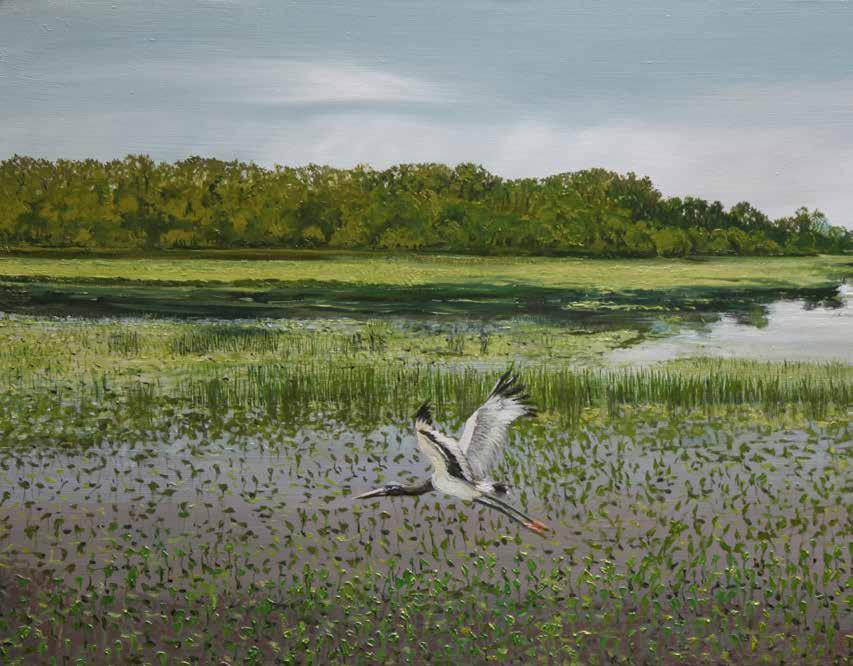


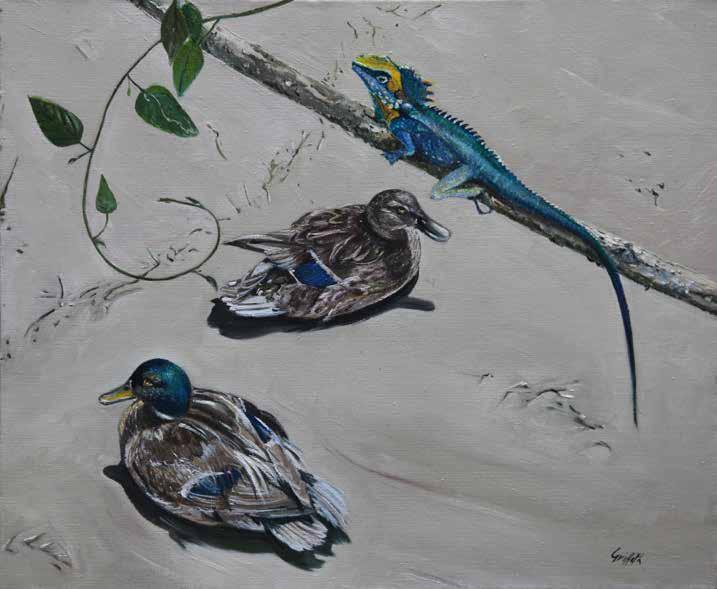
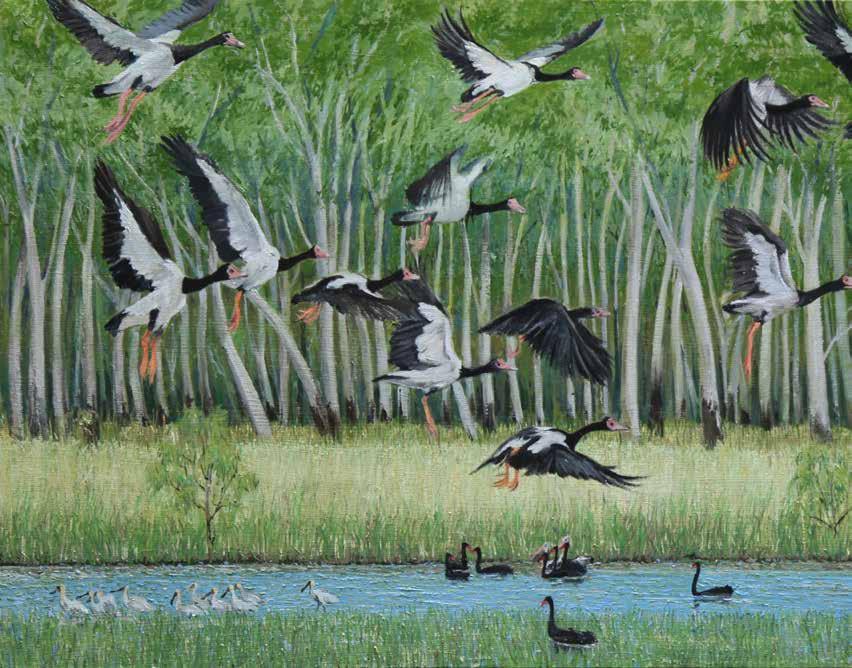







Roosting Ibis 2015

Watercolour
20.5 x 32.5 cm (paper 35.5 x 43.0 cm)
Oil on canvas
50.5 x 61.0 cm
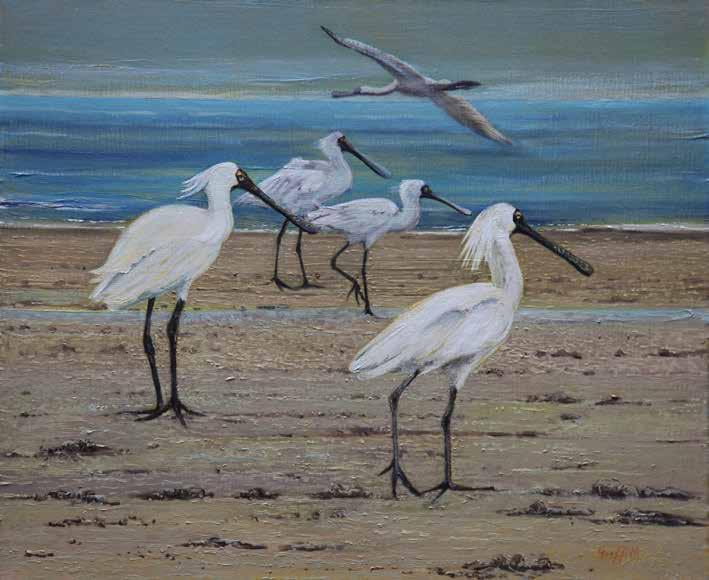




Gouache
55.5 x 75.0 cm




Gouache
60.5 x 102.0 cm
Commissioned by ANSTO / UNSW to promote their Feather Map project
Gecko 1 2015

Watercolour
14.0 x 14.0 cm
(paper 35.5 x 43.0 cm)
Turtles 2015

Watercolour
24.0 x 36.5 cm
(paper 35.5 x 43.0 cm)



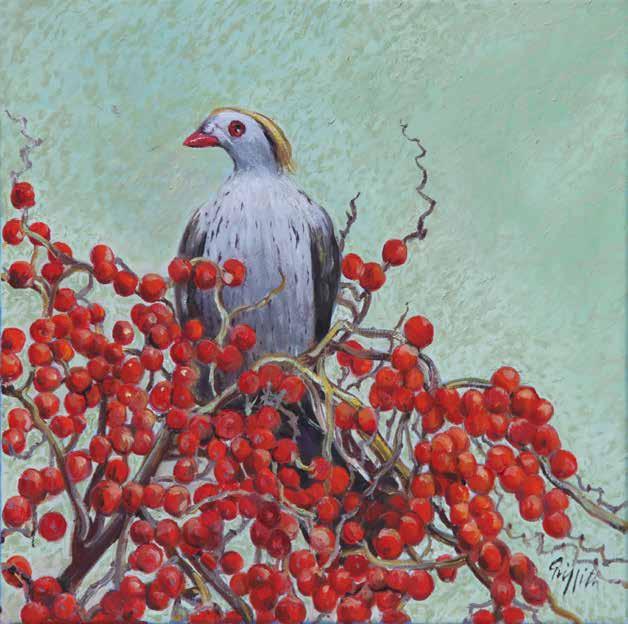


Blue Triangle Butterflies Cavorting 1994

Etching
Image: 45.0 x 34.5 cm
Paper size: 60.5 x 47.0 cm
Ed. 22/60
Gift of Selena Griffith, Sydney, 2015. Donated through the Australian Government’s Cultural Gifts Program, City of Townsville Art Collection, Acquired in 2015
Brolgas at Twilight 1999
Etching
Image: 45.0 x 60.5
Paper size: 57.0 x 76.0 cm
Ed. 5/50
Gift of Selena Griffith, Sydney, 2015. Donated through the Australian Government’s Cultural Gifts Program, City of Townsville Art Collection, Acquired in 2015
Image previous page
Brolgas at Twilight [detail] 1999
Etching
Image: 45 x 60.5
Paper size: 57.0 x 76.0 cm
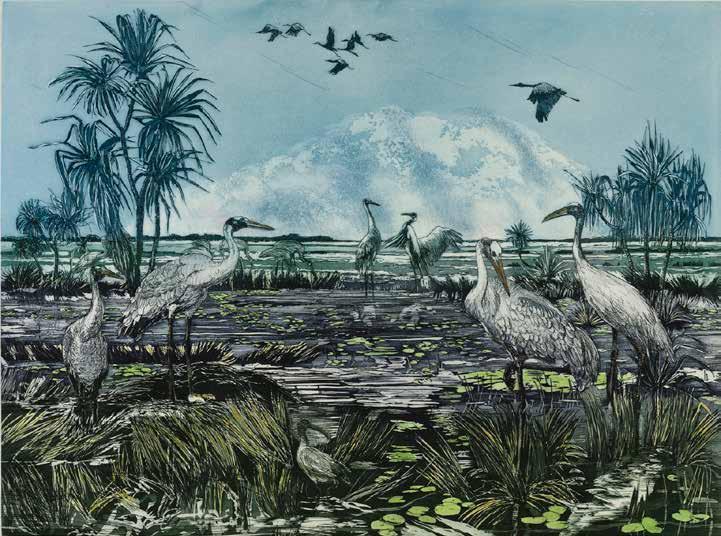
Ed. 5/50
Gift of Selena Griffith, Sydney, 2015. Donated through the Australian Government’s Cultural Gifts Program, City of Townsville Art Collection, Acquired in 2015
Brolgas 1991
Lithograph

Image: 53.0 x 43.0
Paper size: 80.0 x 55.5 cm
Ed. 2/10
Gift of Selena Griffith, Sydney, 2015. Donated through the Australian Government’s Cultural Gifts Program, City of Townsville Art Collection, Acquired in 2015
Pelicans

Etching
Image: 45.0 x 60.5
Paper size: 57.0 x 76.0 cm
Ed. 8/40
Gift of Selena Griffith, Sydney, 2015. Donated through the Australian Government’s Cultural Gifts Program, City of Townsville Art Collection, Acquired in 2015
Wanderer 2011
Etching
Image: 33.0 x 25.0 cm

Paper size: 50.5 x 40.0 cm
Ed. 15/20
Gift of Selena Griffith, Sydney, 2015. Donated through the Australian Government’s Cultural Gifts Program, City of Townsville Art Collection, Acquired in 2015
Ulysses Butterfly and Blue Gum 1994

Etching
Image: 45.0 x 34.5
Paper size: 60.5 x 47.0 cm
Ed. 4/60
Gift of Selena Griffith, Sydney, 2015. Donated through the Australian Government’s Cultural Gifts Program, City of Townsville Art Collection, Acquired in 2015